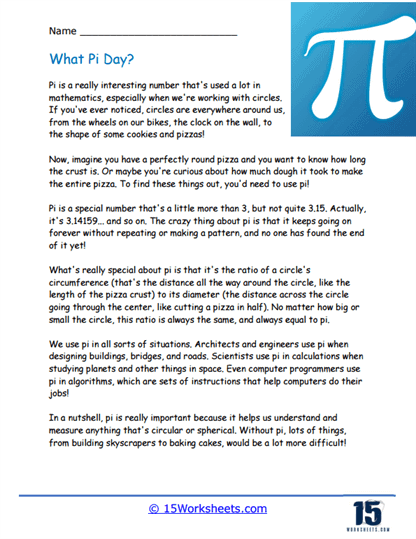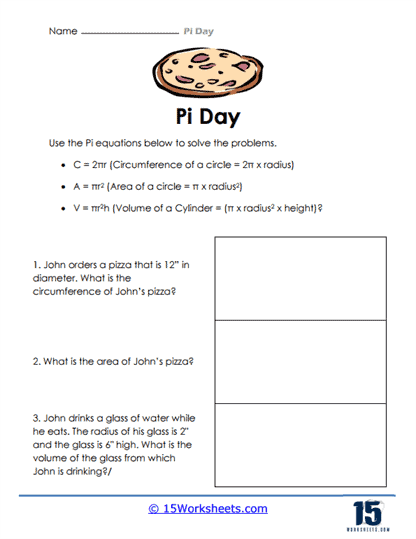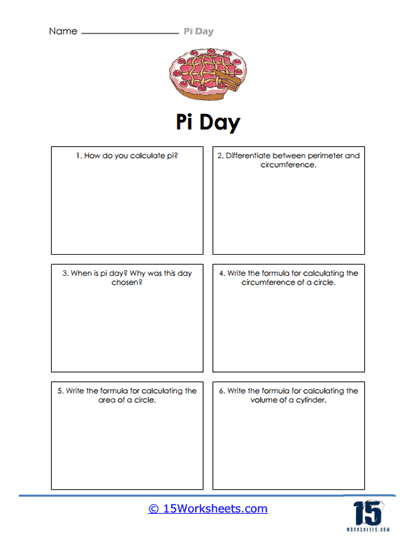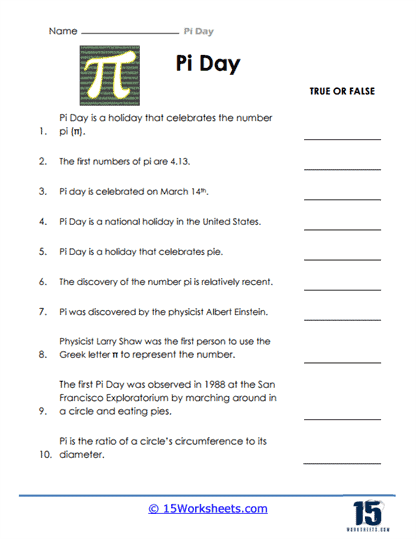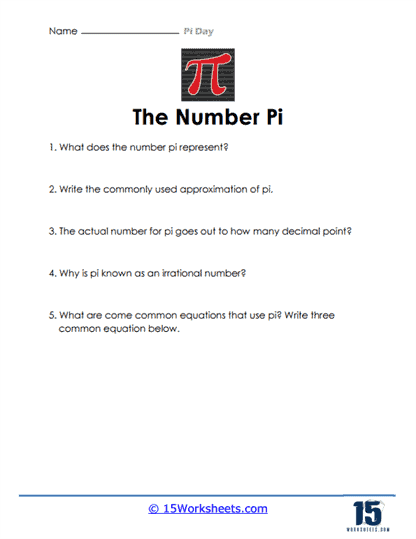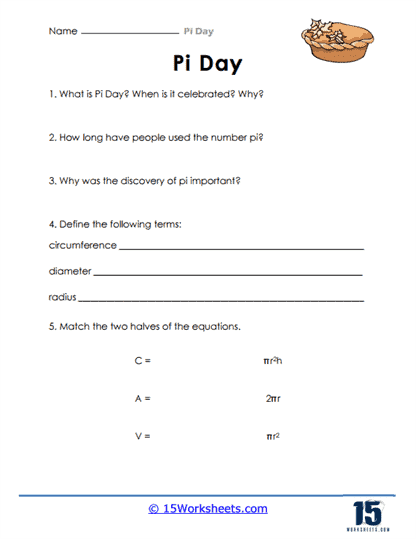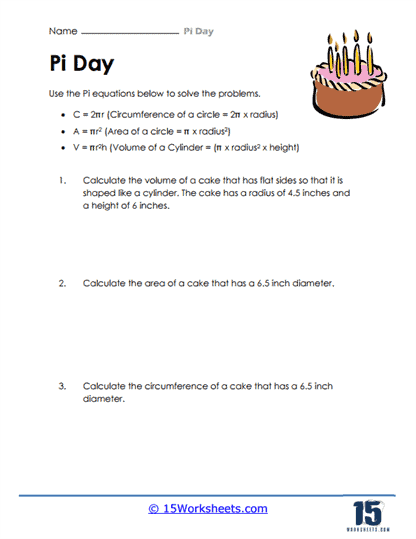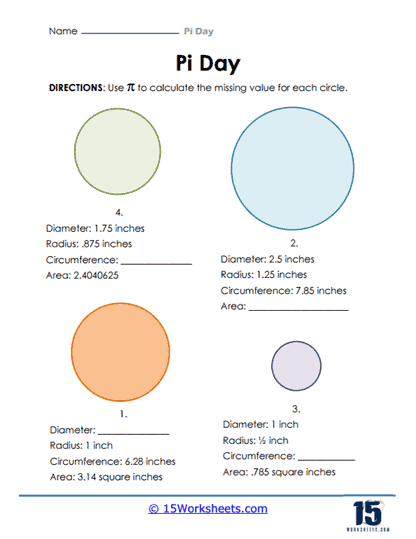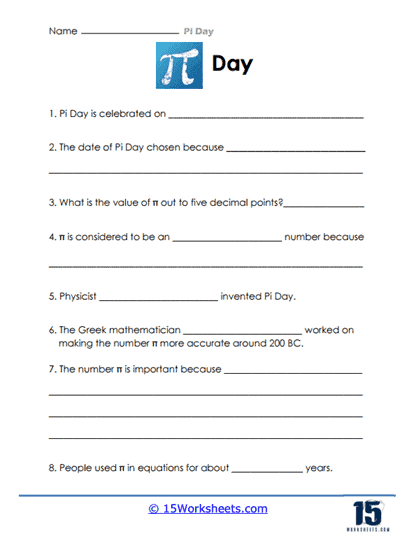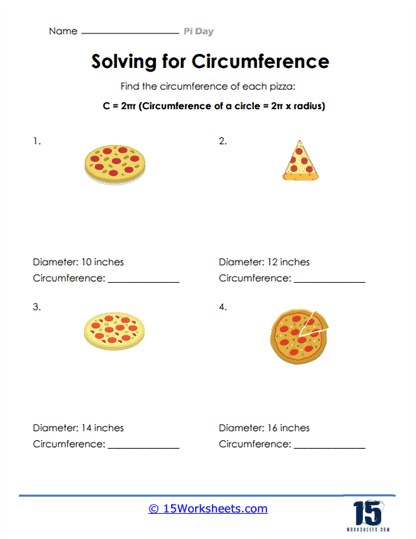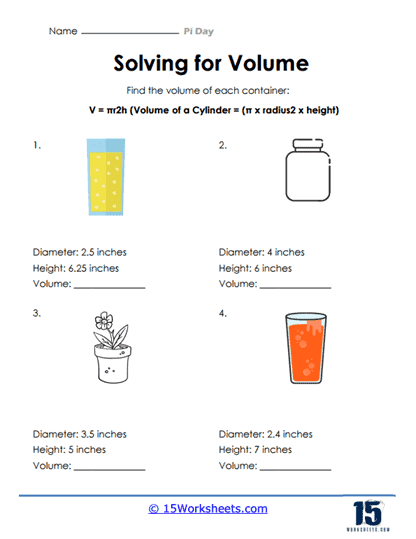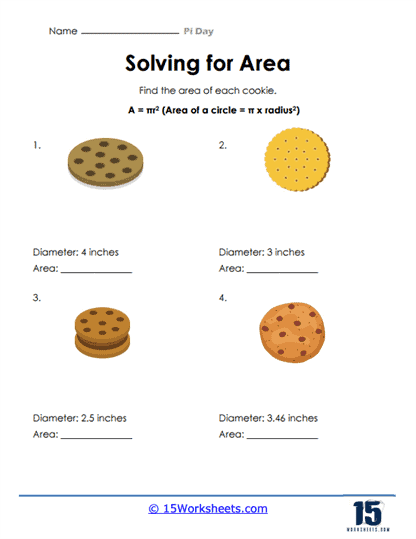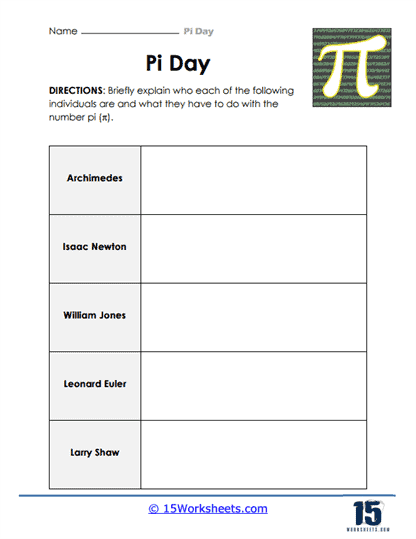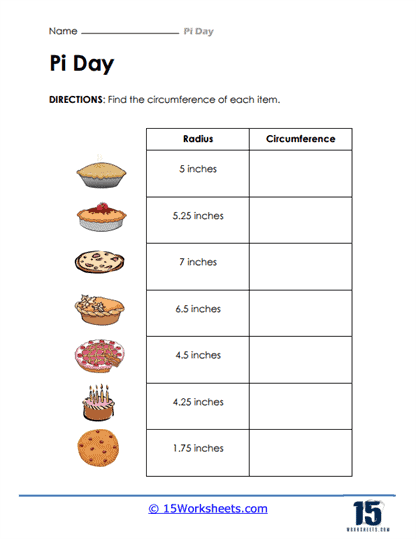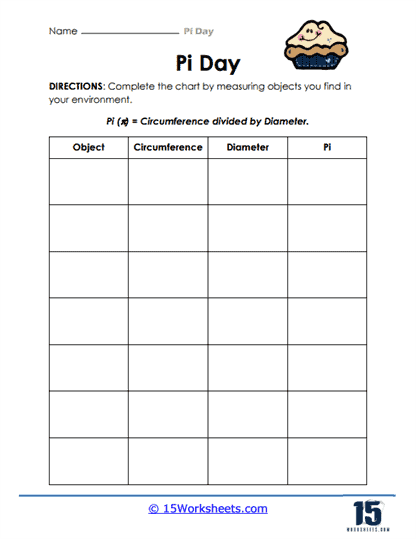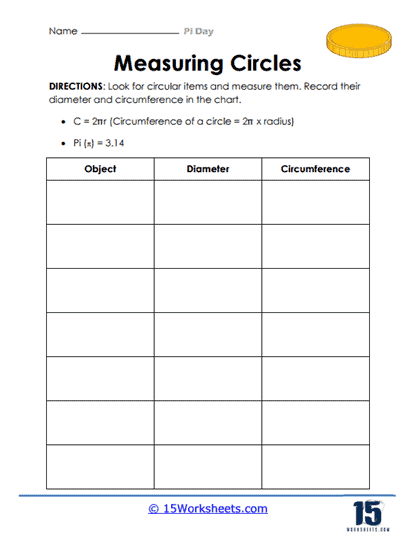Pi Day Worksheets
All About These 15 Worksheets
The collection of Pi Day worksheets will help teachers celebrate and educate students about Pi (π) and its significance, particularly for the annual Pi Day celebrated on March 14th. These worksheets encompass various aspects of Pi and its applications in mathematics, such as geometry and measurement, making them an ideal supplementary resource for classrooms. This collection will help teachers introduce the following skills and concepts to students:
Introduction to Pi (π)
The first set of worksheets introduces students to the concept of Pi (π), explaining its mathematical importance as the ratio of a circle’s circumference to its diameter. The worksheet provides simple explanations for younger students, describing how Pi is found in everyday objects like pizza, cookies, and wheels. This introduction serves as a foundational lesson, ensuring that students understand what Pi represents before diving into calculations.
Practical Application of Pi (Circumference, Area, and Volume)
Several worksheets focus on the practical applications of Pi in calculating the circumference and area of circles, as well as the volume of cylinders. Problems such as calculating the circumference and area of pizzas or the volume of a glass help students see how Pi is used in real-world scenarios. By including relatable objects like pizzas, glasses, and cakes, these worksheets make abstract concepts more tangible, helping students engage with the material more effectively.
Skill Development: Geometry and Formula Application
Through the various worksheets, students are required to apply geometry formulas such as:
C = 2πr (Circumference of a circle),
A = πr2 (Area of a circle),
V = πr2h (Volume of a cylinder).
These formulas help students practice their math skills by calculating dimensions based on given diameters and radii. Additionally, students are prompted to find missing values, ensuring they grasp the process of using Pi to complete these geometric calculations. These activities enhance students’ understanding of circles and cylindrical shapes, developing their abilities in spatial reasoning and formulaic thinking.
True or False Knowledge Test
One worksheet includes a “True or False” section that tests students’ knowledge about Pi Day, the history of Pi, and famous figures associated with the discovery of Pi. This portion helps reinforce historical and factual knowledge about the mathematical constant, offering a well-rounded educational experience that includes both theory and application.
Visualization and Measurement Skills
Some of the later worksheets involve using Pi to calculate missing values for diagrams of circles. This allows students to visually connect the mathematical formulas they’ve learned with actual images of circles and cylinders. Another worksheet involves measuring the circumference of objects in their environment, encouraging hands-on learning where students apply their knowledge to tangible items around them.
Pi Day History and Importance
One of the worksheets highlights the history and significance of Pi Day, allowing students to reflect on the cultural and scientific importance of Pi. It also introduces historical figures like Larry Shaw, who popularized Pi Day, and challenges common misconceptions about Pi’s discovery. This component blends mathematics with history, providing a broader context for Pi’s relevance both in ancient and modern times.
Fun and Creative Learning Approaches
The worksheets are designed to make learning about Pi fun, incorporating pies and pizza-themed problems to keep students engaged. By relating mathematical concepts to everyday activities like eating pizza or calculating the size of a cake, these worksheets make math feel more interactive and less intimidating. The engaging visuals and relatable themes also ensure that students enjoy the process of learning something that might otherwise seem challenging.
What is Pi Day?
Pi Day is an annual celebration that takes place on March 14th (3/14) to honor the mathematical constant Π (pi). Pi is the ratio of a circle’s circumference to its diameter, and its decimal representation begins with 3.14, hence the choice of March 14th as Pi Day. Pi is an irrational number, meaning its decimal representation goes on indefinitely without repeating. It has been calculated to over one trillion digits beyond the decimal point.
The concept of Pi Day was first organized by physicist Larry Shaw in 1988 at the Exploratorium, a science museum in San Francisco. Since then, the day has been celebrated by math enthusiasts, educators, and students worldwide. In 2009, the U.S. House of Representatives passed a resolution recognizing March 14th as National Pi Day, encouraging schools and educators to observe the day with activities that teach students about the significance of pi in mathematics and science.
Pi Day celebrations often involve various math-related activities, puzzles, and games that highlight the importance and fun of mathematics. It is also common for people to enjoy eating pie or other circular foods as a playful nod to the mathematical constant. Pi Day serves as an opportunity to engage in discussions about mathematics, explore the beauty of numbers, and inspire a love for learning and problem-solving.
Teaching Tips For Pi Day
Pi Day is an excellent opportunity for educators to make mathematics engaging and fun for students. Here are some teaching tips for celebrating Pi Day in the classroom:
Introduce the Concept of Pi
Begin by explaining the significance of pi in mathematics, its role as the ratio of a circle’s circumference to its diameter, and its properties as an irrational number.
Discuss the historical context of pi, how it has been used throughout history, and the mathematicians who have contributed to our understanding of this constant.
Hands-on Activities
Encourage students to measure the circumference and diameter of various circular objects (e.g., lids, plates, wheels) and calculate pi by dividing the circumference by the diameter. This hands-on experience helps students understand the concept of pi more concretely.
Challenge students to memorize as many digits of pi as they can and hold a friendly competition to see who can recite the most digits.
Invite students to create pi-inspired artwork, such as designing posters, drawing circular patterns, or writing pi-kus (a spin on haikus that use the first three digits of pi as the syllable count for each line).
Introduce students to mathematical puzzles and games related to pi, such as calculating the area or circumference of circles, solving word problems, or finding the volume of cylinders.
Real-world Applications
Highlight the importance of pi in various fields, such as engineering, physics, and architecture, by providing examples of how pi is used in real-world situations.
Celebrate with Real Pie
As a fun and tasty way to celebrate Pi Day, bring in pies or other circular treats for students to enjoy. You can even incorporate math lessons by discussing the geometry of slicing the pie or calculating the area of a pie slice.
By incorporating these teaching tips, educators can create an engaging and memorable Pi Day experience that fosters a love for mathematics and helps students better understand the concept of pi.

